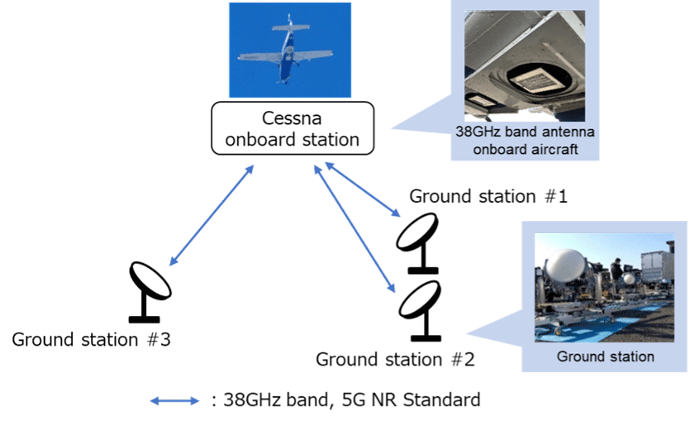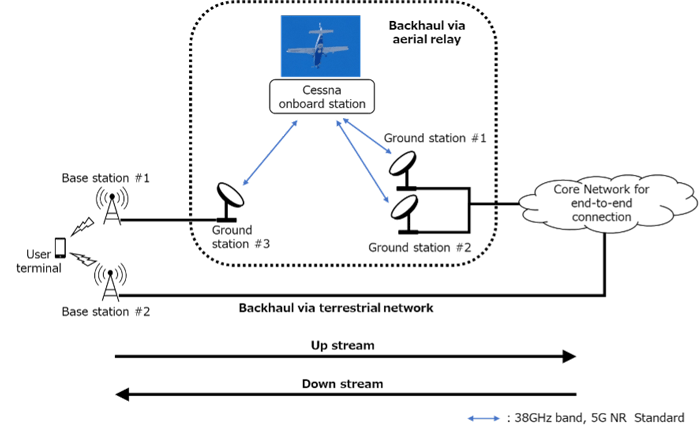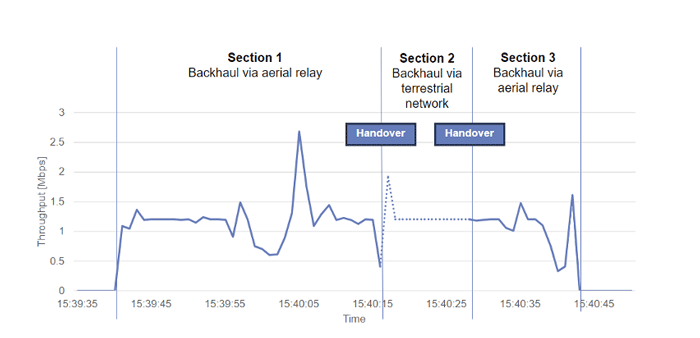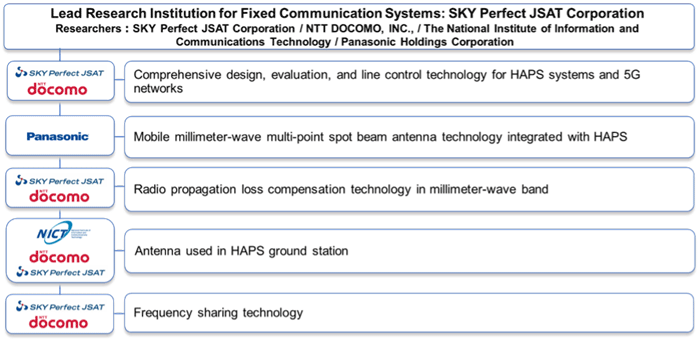
Japanese Consortium Achieves World's First Demonstration of 5G Communication from Altitude of 4km Using 38GHz Band
— Major Step Toward Realization of 5G Communication from Stratosphere —
May 28, 2024
TOKYO, JAPAN, May 28, 2024— SKY Perfect JSAT Corporation, NTT DOCOMO, INC., the National Institute of Information and Communications Technology (NICT) , and Panasonic Holdings Corporation (Panasonic HD) jointly announced today that they have successfully conducted a 5G communication verification test in the 38GHz band from an altitude of approximately 4km using a small Cessna aircraft operated by Kyoritsu Air Survey Co., Ltd. simulating the eventual use of High-Altitude Platform Stations (HAPS) . The demonstration was the first of its kind in the world.
In this groundbreaking trial to demonstrate the practical application of 5G feeder link and backhaul line for HAPS, a Cessna aircraft was equipped with newly developed communication equipment (“Cessna onboard station”) that is expected to be deployed eventually in HAPS. Additionally, a lens-type antenna with an auto-tracking function was used as the HAPS ground station (“ground station”).
The trial established an aerial relay backhaul line between the Cessna aircraft, flying at altitude of approximately 4km, and three ground stations, using the 5G New Radio (NR) standard with 38GHz band radio waves, which is a novel approach for terrestrial 5G networks. The achievement of multiple backhaul line consisting of aerial relays using the 5G NR standard with 38GHz band radio waves was a world first in telecommunication technology.

Verification test
With 5G evolution underway and 6G implementation on the horizon, various efforts are being made to expand coverage areas. Non-Terrestrial Networks (NTN) using HAPS is a promising technology for such expansions, so the results from this demonstration will help accelerate the practical application of HAPS networks.
The four organizations involved in this project are committed to continuing their joint efforts, aiming at the early delivery of 5G from the stratosphere via an NTN using HAPS.
The demonstration is part of a project focused on wireless communication systems using HAPS led by Japan’s Ministry of Internal Affairs and Communications.
Appendix 1
1. Test details
The trial was conducted using the following setup:
① A 38GHz band 5G Non-Terrestrial Networks (NTN) base station and core network device, developed for installation in HAPS were mounted in a Cessna aircraft.
② Lens-type antenna with an automatic tracking function, designed to transmit and receive 38GHz band radio waves with high gain and a sharp beam, was used as the ground station.
③ Establish multiple data links using the 5G New Radio (NR) standard between the aircraft and three ground stations.
By simultaneously connecting and relaying any two ground stations that formed the backhaul line via the Cessna onboard station, it was possible to establish a data link between the two ground stations: one connected to the 5G terrestrial network (ground stations 1 & 2) and the other connected to the terrestrial base station communicating with the terminal (ground station 3). This setup demonstrated the backhaul line of the 5G terrestrial network via an aerial relay (dotted line in figure).
By applying this technology to the backhaul line between the base station communicating with the terminal and the end-to-end communication core network, end-to-end communication to the user terminal was achieved. In addition, handover between the aerial relay backhaul base station (base station 1) and the terrestrial backhaul base station (base station 2) was demonstrated.

Overview of the verification test
2. Key achievements
- Established an aerial relay backhaul link using the 5G NR standard in the 38GHz band.
- Performed a handover between the terrestrial backhaul base station and the aerial relay backhaul base station.
To verify these two points, the end-to-end throughput between core communication network and the communication terminal was measured. Measurements were taken in both directions: from the end-to-end communication core network to the communication terminal (downlink) and from the terminal to the end-to-end communication core network (uplink).
The graph below illustrates the time variation of downlink throughput. In section 1, the aerial relay backhaul line was established, allowing data transmission from the end-to-end communication core network to the terminal. In section 2, data was transmitted over the terrestrial backhaul line. When transitioning from section 1 to section 2, the handover was performed without interruption of data communication. Furthermore, when transitioning to section 3, which was reconnected to the aerial relay backhaul, the handover was performed without any interruption in data communication. These results met the initial verification objective. It is also worth noting that the above verification was also successful in the uplink.

Result of the test
3. Technical developments
The trial focused on specific technical developments by replicating the flight conditions of HAPS in the stratosphere, some 20km above ground.
Tracking technology of antennas and communication equipment for HAPS
When using a fixed-wing model for HAPS, it is critical for the HAPS-mounted antenna to have precise control of the beam direction and to minimize frequency fluctuations due to the Doppler effect, especially when communicating at high frequencies in the millimeter-wave band.
Within this R&D framework, a technology for 5G NR communication was successfully demonstrated using the HAPS-mounted antenna and communication equipment in a flight environment, accurately directing the 38GHz band beam to three ground stations. This technology is adaptable to various flight conditions, adjusting to the aircraft's attitude, speed, direction, position, and altitude as it turns.
Tracking technology of ground station antenna and communication equipment
Due to the effects of stratospheric winds and varying weather conditions, HAPS must continually change its trajectory. The development of high-precision tracking technology is essential for ground station antennas and communication equipment to accurately and continuously track the HAPS with the extremely narrow and sharp 38GHz band antenna beam. The ground station antenna used in the trial had a minimum beamwidth of 0.8 degree, enabling a tracking method that consistently tracked the Cessna aircraft within this angular range.
Line switching and control technology for HAPS network
To integrate HAPS into 5G and 6G mobile networks, flexible line switching, and control will be necessary between the existing terrestrial network and the HAPS-based stratospheric network. The trial verified the handover between the terrestrial backhaul base station and the aerial relay backhaul base station using the 5G NR standard in the 38GHz band. The trial achieved seamless handover with no interruption in data transmission when the user equipment moved across the coverage areas of both base stations. This success demonstrated the feasibility of flexible link control technology that coordinates between the terrestrial network and the HAPS network.
Rain attenuation compensation algorithm in radio wave propagation path
Radio waves in the 38GHz band can be significantly weakened by rain, requiring practical countermeasures such as site diversity. The trial successfully tested an algorithm that automatically compensates for rain-induced attenuation, such as site diversity, in sync with the 5G network, making adjustments according to changes in link quality caused by rain.
It was confirmed that all initial development objectives were met. In addition, with a view to the future deployment of HAPS, the trial provided measurement data that will support the practical application and standardization of HAPS and identify areas for further technical development and performance enhancement. In the future, the four partners plan to use these results to realize 5G communication services from the stratosphere via HAPS, thus contributing to the realization of NTN.

Roles of verification test participants
Appendix 2
Overview of R&D
Purpose
The purpose of this R&D is to develop a HAPS system that can provide timely, high-speed, and high-capacity communication lines to meet the demand for backhaul lines to base stations in various applications expected in the era of 5G Evolution & 6G, and also for disaster response and recovery, using the broadband frequency of the millimeter wave band (Q/V band; 36.0-42.5GHz band centered on 38.0-39.5GHz) and HAPS. Another purpose is to improve the frequency utilization efficiency of HAPS communication using the millimeter-wave band and to establish elemental technologies for the practical application of HAPS systems.
Contents
To achieve the above, the development targets include a millimeter-wave communication device to be mounted on a HAPS and a corresponding ground station. Even when the HAPS position and flight attitude change, wireless communication must be ensured by controlling the direction of radio wave transmission while reducing interference from radio waves from other terrestrial systems. In addition, technologies such as switching between multiple ground stations (site diversity) will be used to ensure connectivity equivalent to that of mobile phone backhaul lines using the conventional stationary satellite system in Japan, even in the millimeter-wave band where the effect of rain attenuation can be significant.
The target for frequency utilization efficiency is to improve the throughput from around 3 bits/symbol to 4 bits/symbol, or more than 1.1 times the throughput of geostationary satellite systems.
This R&D is being conducted as part of the Ministry of Internal Affairs and Communications' 'Research and Development for the Expansion of Radio Wave Resources (JPJ000254)’.
Glossary
38GHz band
38.0-39.5GHz frequency band was designated for HAPS fixed communication at 2019 World Radiocommunication Conference.
High-Altitude Platform Stations (HAPS)
Radio station onboard unmanned aircraft capable of flying in the stratosphere up to several months and equipped with repeaters, etc. to cover a 100-200km diameter for the skies, seas and unpopulated/mountainous regions where coverage has been economically unfeasible.
feeder link
Relay communications between HAPS and ground station.
backhaul line
Fixed line that supports high-speed, high-capacity transmission between wireless base stations and core mobile network. The Core mobile network acts as a command center, managing authentication, authorization, and communication sessions (Control Plane). It also transfers data between the application server outside the core network and the terminal (User Plane).
5G New Radio (NR) standard
New 5G wireless access technology, developed by 3GPP project in which various national standardization bodies are working to coordinate mobile-communication specifications.
The achievement of multiple backhaul line consisting of aerial relays using the 5G NR standard with 38GHz band radio waves was a world first in telecommunication technology
As of April 3, 2024, according to research conducted by Panasonic HD.
Non-Terrestrial Networks (NTN)
A system that utilizes a variety of communication platforms, such as satellites, HAPS, drones, etc., to establish a multi-layered connection across different spatial dimensions, including sea, air, and space, extending beyond terrestrial boundaries.
project focused on wireless communication systems using HAPS led by Japan’s Ministry of Internal Affairs and Communications
Core plan of this R&D:
https://www.soumu.go.jp/main_sosiki/joho_tsusin/eng/pressrelease/2020/6/15_1.html
https://www.soumu.go.jp/main_sosiki/joho_tsusin/eng/pressrelease/2020/6/15_1.html
end-to-end communication core network
The entire path connecting two communicating parties, or both ends of that path. Also known as E2E.
handover
Technology that switches base stations while maintaining communication when a terminal moves to another cell.
site diversity
Technology that switches between multiple ground stations by receiving a wireless signal through two or more antennas.
frequency utilization efficiency
Higher speed and higher capacity communication results in the transmission of more bits within a unit of frequency or time.
About SKY Perfect JSAT
SKY Perfect JSAT is Asia’s largest satellite operator with a fleet of 17 satellites, and Japan’s only provider of both Multi-channel Pay TV broadcasting and satellite communications services. SKY Perfect JSAT delivers a broad range of entertainment through the “SKY PerfecTV!” platform, the most extensive in Japan with over 2 million subscribers. SKY Perfect JSAT’s satellite communications services, which cover Asia, Indian Ocean, Middle East, Pacific Ocean and North America, play a vital role in supporting communications infrastructures for mobile backhaul, government, aviation, maritime, oil & gas and disaster recovery.
For more information, visit our corporate website (https://www.skyperfectjsat.space/en) and Space Business website (https://www.skyperfectjsat.space/jsat/en/).
About NTT DOCOMO
NTT DOCOMO, Japan's leading mobile operator with over 89 million subscriptions, is one of the world's foremost contributors to 3G, 4G and 5G mobile network technologies. Beyond core communications services, DOCOMO is challenging new frontiers in collaboration with a growing number of entities ("+d" partners), creating exciting and convenient value-added services that change the way people live and work. Under a medium-term plan toward 2020 and beyond, DOCOMO is pioneering a leading-edge 5G network to facilitate innovative services that will amaze and inspire customers beyond their expectations.
About NICT
The National Institute of Information and Communications Technology (NICT) is Japan’s sole National Research and Development Agency specializing in the field of information and communications technology and is charged with promoting the ICT sector as well as research and development in ICT, which drives economic growth and creates an affluent, safe and secure society.
For more information, visit https://www.nict.go.jp/en/
About the Panasonic Group
Founded in 1918, and today a global leader in developing innovative technologies and solutions for wide-ranging applications in the consumer electronics, housing, automotive, industry, communications, and energy sectors worldwide, the Panasonic Group switched to an operating company system on April 1, 2022 with Panasonic Holdings Corporation serving as a holding company and eight companies positioned under its umbrella. The Group reported consolidated net sales of 8,496.4 billion yen for the year ended March 31, 2024. To learn more about the Panasonic Group, please visit: https://holdings.panasonic/global/
Media Contact
SKY Perfect JSAT Corporation
Corporate Communications & Investor Relations Division
E-mail: pr sptvjsat.com
sptvjsat.com
 sptvjsat.com
sptvjsat.com
NTT DOCOMO
6G Network Innovation Department
E-mail: 6gni_ntn ml.nttdocomo.com
ml.nttdocomo.com
 ml.nttdocomo.com
ml.nttdocomo.com
National Institute of Information and Communications Technology
Press Office, Public Relations Department
E-mail: publicity nict.go.jp
nict.go.jp
 nict.go.jp
nict.go.jp
Panasonic Holdings Corporation
Technology PR section
E-mail: crdpress ml.jp.panasonic.com
ml.jp.panasonic.com
 ml.jp.panasonic.com
ml.jp.panasonic.com